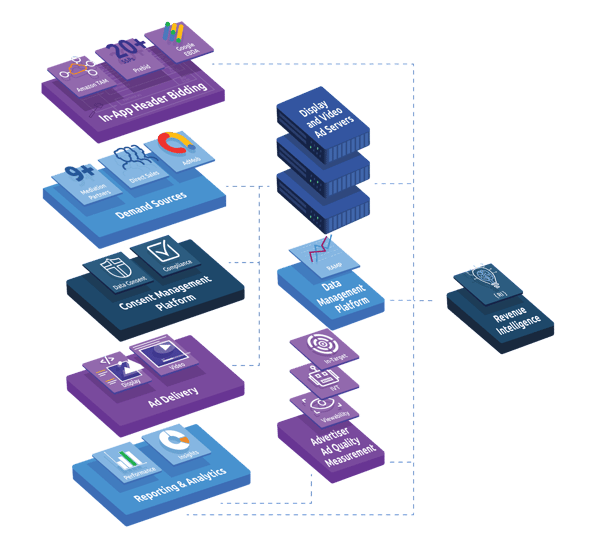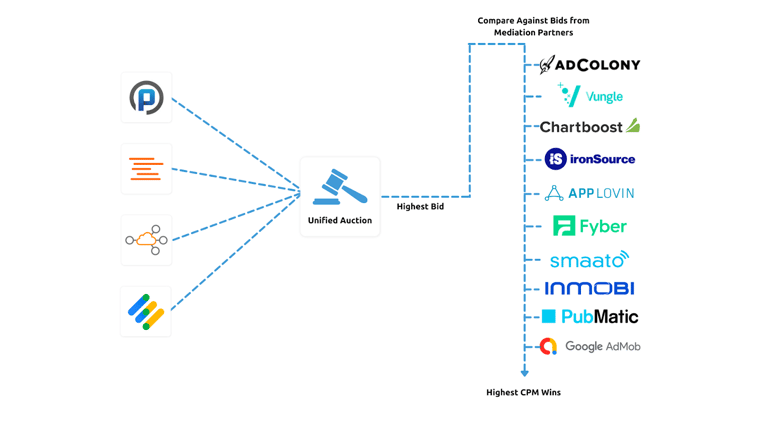Playwire's Mobile Ads SDK
April 3, 2022
Editorial Policy
All of our content is generated by subject matter experts with years of ad tech experience and structured by writers and educators for ease of use and digestibility. Learn more about our rigorous interview, content production and review process here.

Key Points
- The way mobile ads SDKs have been done in the past is archaic. We're looking to the future.
- Playwire's mobile ads SDK includes header bidders, mediation partners, and a CMP.
- Both setup and the call process are designed for simplicity and effectiveness.
We call it RAMP® for App (Revenue Amplification Management Platform), but many mobile app developers and app publishers like you call it a game-changer. Playwire's mobile ads software development kit (SDK) is innovative and effective. We like saying that, and today, we're going to provide the data to back it up.
This post is all about our mobile ads SDK - its overall purpose, its parts, and its processes. You'll come away with a deeper understanding of mobile ads SDKs in general and how Playwire's is better. Read on to learn more.
We didn't enter the ad tech arena just to bring more of the same. We bring something new to app publishers, and that includes our mobile ads SDK. Interested in ramping up your app's mobile advertising revenue? Contact us.
-- Article Continues Below --
The Complete App Monetization Resource Center
The Point: Getting Away from the Old Ways
Apps may be the new thing in mobile, but at the moment, programmatic advertising is far more primitive for apps than it is for websites. To date, mobile ads SDKs that do programmatic and header bidding have been done roughly. You could call them archaic. The point of our mobile ads SDK is to reverse that trend.
Every day, the Playwire team pushes our SDK closer to the web standard. App publishers deserve a functional and efficient process, and they shouldn't have to wait any longer for it.
However, we also recognize that we can't just bring innovation to the table. We also have to do what it takes to bring in real ad revenue right now for the app publishers we work with. That means partnering with the core mediation partners and jumping through all the right hoops. And we do that, but we never stop looking forward, factoring in things like header bidding and similar technologies.
The Parts: Header Bidders, Mediation Partners, CMP

That's the point, but what does this thing actually look like? Playwire's mobile ads SDK is a relatively lightweight SDK because it is simply an SDK of SDKs. It wraps up and manages the dependencies for SDKs that cover:
- Header bidders
- Mediation partners
- Consent management
Let's look at each of those in a bit more detail.
-- Article Continues Below --
The Complete Guide to App Monetization for Publishers
Header Bidders
Our SDK uses three header bidding partners: Prebid, Amazon Transparent Ad Marketplace (TAM), and Google adExchange Bidding in Dynamic Allocation (EBDA). Within each of those, we have several bidders configured. That way, when we send out a call for bids to, say, TAM, the call fans out to three or more other bidders, meaning it is much more likely to be filled.
Mediation Partners
Mobile header bidding is becoming more popular, and we believe it will grow to dominate the app space as it has for web. But there are times that we don't always get a solid bid back from our app header bidders when we call them. So, we integrate several mediation partners to make sure no impression goes unfilled.
Our mediation partners include big names like AppLovin, Fyber, Vungle, and the like. This is where the majority of the requests get filled, but as a last line of defense, we capture demand from Google's AdMob SDK (via Google AdManager and Google mobile ads SDK) if and when it exists.
Consent Management Platform (CMP)
It would be irresponsible to promote a mobile ads SDK as comprehensive in 2022 without including a consent management platform (CMP). That's why we integrate Google's CMP, Funding Choices, into our SDK.
This CMP covers all relevant privacy laws and manages privacy settings and tracking opt-ins and opt-outs. That way, you don't have to worry about running into legal trouble just because you're trying to run ads on your mobile app.
-- Article Continues Below --
The Process: Setup and How It Works
With all the parts of Playwire's SDK covered, let's take a look at implementation and how it works once it's all set up.
Setup
We work hard to make the setup of our SDK easy for publishers. We've already managed all of the dependencies between each of the individual SDKs integrated into our SDK. That means you only have to set up and test one SDK - ours - not seven or eight of them.
Realistically, the first-time setup of our SDK is going to take a developer a couple of days. In terms of SDK integrations, that isn't all that long, and the best part is that future updates take just a fraction of that time after the initial setup is complete.
How It Works
Once you've got our mobile ads SDK integrated, the process is simple. Here's how it works:
- When a user of your app triggers a bid request, that request runs a unified auction between our three header bidders and demand from our direct sales team.
- Once we receive a bid, we compare that to bids from mediation partners. The SDK goes through each of our 9 integrated mediation partners in order of importance.
- In the rare instance that we get no bids from either our header bidders or mediation partners, the last line of defense is Google mobile ads demand.
- Meanwhile, Google's CMP ensures that your app is compliant with all relevant privacy laws.

It's simple, effective, and innovative, which the data proves, and we make it better every day.
Get the Leading Mobile Ads SDK
The best innovations in advertising tech simplify the complex and make publishers' lives easier. We believe our mobile ads SDK fits that bill perfectly. With a few simple parts, easy setup, and a standardized process that drives higher CPMs and user engagement for the highest impact app ad formats (interstitial ads, banner ads, rewarded video ads, etc.), our RAMP for app will not steer you wrong.
If you're ready to try it out or if you have questions, our expert team is here to help. Reach out to us by filling out the online contact form.

-1.png?width=800&height=157&name=1-playwire-logo-primary-2021%20(1)-1.png)






